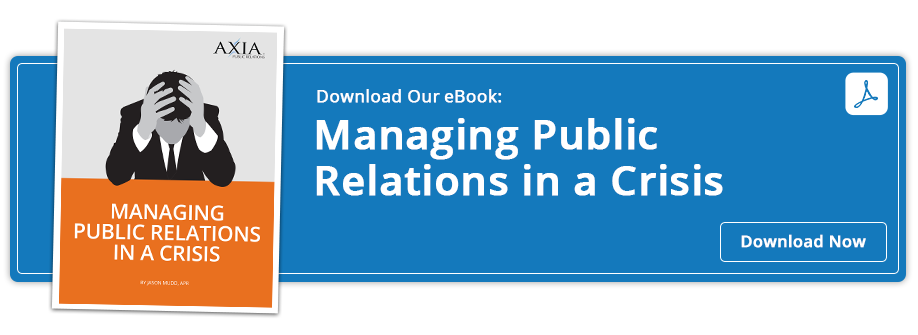What are successful, large corporations doing for crisis management?
By Lisa GoldsberryJune 13, 2016
 Learn the top 4 ways your company can use PR to lessen the impact and longevity of a crisis
Learn the top 4 ways your company can use PR to lessen the impact and longevity of a crisis
You see it all the time: There’s a news story about some large company screwing up in a major way, yet coming out of it relatively unscathed (and often with a boost in profits to boot). How do they do it? More importantly, what can your company learn from their experiences?
In this day of 24-hour news and things that go viral in the night, it’s no longer a question of if your company will go through a crisis, but when. Fortunately, there are plenty of examples to choose from of large corporations using PR crisis management tools in a successful way. Discover the right methods for dealing with a crisis to keep your company out of hot water.
- Remain consistent in your responses.
Flip-flopping on your messages signifies that you are not in control. It also makes you look dishonest, and the media and public will pounce as a result. Additionally, this gives journalists more to report on, which serves to prolong the story.
A good example of this comes from Kraft Foods. Several years ago, the company posted a photo on Facebook of the ubiquitous Oreo cookie with rainbow-colored filling in honor of Gay Pride Month. While many were in favor, tens of thousands of non-supporters expressed outrage and threatened boycotts. In response, the company gracefully expressed its commitment to diversity as it communicated with the media and detractors. The company also thanked its many supporters, who eventually drowned out the negative comments and made the story go away quickly.
- Use all media at your disposal.
Gone are the days when you could handle a crisis with just a news release or news conference. You must use earned, owned and shared media (social media, online reviews and user generated content on channels and sites you share with other companies and individuals) effectively to reach all key stakeholders and deliver a clear, accurate response.
FedEx successfully demonstrated this crisis management strategy after a YouTube video surfaced showing a FedEx delivery driver carelessly throwing a boxed computer over a fence. The video went viral, receiving millions of views and becoming fodder for the late-night talk shows. The company issued a series of tweets and posted a blog by a senior vice president titled “Absolutely, Positively Unacceptable” that included an apology for the driver’s behavior and explained how FedEx made things right with the affected customer. The company also posted its response on its YouTube channel, all of which was reported by the media. As an added note, FedEx reportedly experienced an increase in delivery volume that season.
- Respond quickly.
Taking too much time to decide on a statement or course of action allows others to weigh in first, which can overshadow or nullify your response when you do present it. It is vital to know all the places your company is mentioned and what people are saying to quickly squash a crisis before it gains momentum. You should also have a crisis management plan so you don’t have to start from scratch every time a situation arises.
KitchenAid exhibited the importance of this point after an employee mistakenly used the company Twitter account (instead of a personal account) to make negative comments about President Obama and his late grandmother. The company CEO responded on Twitter within 15 minutes of the original post to apologize and explain the steps KitchenAid would take to prevent such a mistake in the future. In doing this quickly, she diminished the crisis and protected the brand.
- Hire a PR agency to help you.
Crafting the right messages and setting the proper tone of empathy and authenticity early on can go a long way toward mitigating a crisis. For example, Ford Motor Company – after a shaky start in dealing with its recall crisis – brought in a new communications team and gave the public the response it needed. The company acknowledged its mistake, apologized and explained how it was seeking solutions, all of which helped the company maintain its position as the country’s second-biggest automaker.
The right PR firm can help you implement a plan, clarify your company’s position and get you through a crisis with minimal damage. At Axia Public Relations, we will help you protect your reputation and brand before, during and after a crisis. Contact us today or download our e-book Managing Public Relations in a Crisis to learn more.

 Lisa Goldsberry is a blogger for Axia Public Relations with more than 15 years of public relations experience. She specializes in business and technology PR. Lisa has worked for Axia since December 2013. Learn more about Lisa Goldsberry. Connect with Axia on Twitter @axiapr or tell us what you think in the comments below.
Lisa Goldsberry is a blogger for Axia Public Relations with more than 15 years of public relations experience. She specializes in business and technology PR. Lisa has worked for Axia since December 2013. Learn more about Lisa Goldsberry. Connect with Axia on Twitter @axiapr or tell us what you think in the comments below.
Featured image credit: 123rf.com
Topics: public relations, crisis communications


Comment on This Article